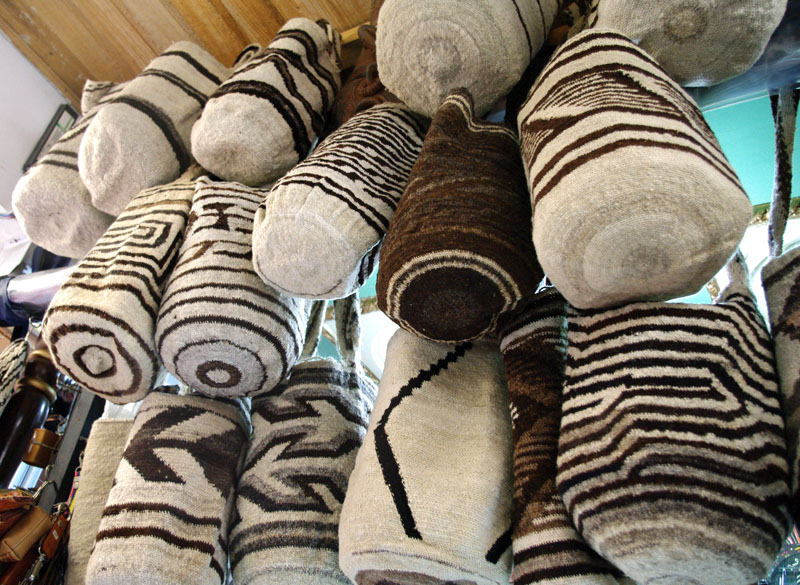Kogi wisdom claims, “If it doesn’t fit into a mochila, it doesn’t fit in life.” These are words that resonate from the snow-capped plateaus of the Sierra Nevada and which have found followers on Bogotá streets. Just stroll La Candelaria and you’ll see many varieties of mochilas hanging from the shoulders of students and their teachers. We all know that books, like digital cameras, have a special place in one’s life and inside a soft pouch.
The mochila represents a link to an indigenous present, a hopeful sign that these cultures are surviving in the postmodern world. Although we are forced to travel light these days, the mochila is more than a fancy bohemian accessory – it is part of the human equipment of a continent that survived a conquest and fashion values of the Old World.

More colorful than their counterparts from the Sierra Nevada, Wayúu mochilas also utilize symbolic patterns expressive of cultural traditions.
Two styles of mochila have gained status in Bogotá and both come from the north of the country; the Arhuaca and the Wayúu. If you own an Arhuaca mochila you will recognize the comforting rounded shape, smell of lanolin and mysterious designs. Wayúu mochilas are slightly less common but they are becoming more popular for their way of blending ancient forms with startling color combinations.
Not everyone who carries a mochila may know or care exactly what they or the shapes sewn into them signify, but they are certainly affected by their special quality. An indigenous mochila is more than just a bag; it becomes a part of you. “All kinds of Colombian people want them,” one shop-owner told me, “and foreigners buy them because they fall in love with them.”
The indigenous group that inhabits the mountains of the Sierra Nevada de Santa Marta, and hence carries its name makes Arhuaca mochilas. There are various mochilas for different purposes; an everyday mochila for men and women, a mochila for carrying babies, and mochilas exclusively for coca-chewing paraphernalia. There are also tiny mochilas for ceremonial purposes.
Women using a large straight needle similar to ones used for sewing leather produce these items. In fact their fabrication is such a uniquely feminine activity that mochilas are symbolically viewed as an extension of the womb.
The figures used in Arhuaca mochilas can be representations of supernatural beings, or natural features, animals and insects. They are all highly stylized and each one has a specific meaning. These shapes have their origin in pre-Colombian times, and some of them have similarities to objects in the Gold Museum. The evocative names of some of these figures give an idea of the world the people of this zone inhabit; “Coca leaf,” “Rattlesnake,” “Thoughts of a woman,” and “The four corners of the earth.”
The Wayúu people live on the Guajira peninsula, an area of mostly desert near the border with Venezuela (the Wayúu are in fact transnational) and make a mochila that is similar in shape to the Arhuaca, but broader with a drawstring fastening that has extravagant tassels at each end. The most obvious difference though is in their color; where Arhuaca mochilas usually display a limited palette of neutral colors obtained from natural dyes, the Wayúu use of synthetic thread introduced by white traders passing through this transition zone.
[otw_is sidebar=otw-sidebar-9]
Wayúu mochilas are usually crocheted and again it is the women who perform this task. The patterns that appear on the mochilas are traditional, and each shape is related to a particular being or object and aspect of Wayúu belief.
Wayúu mochilas combine aspects of the indigenous and the imported, and perhaps for this reason they have been more subject to adaptation than their Arhuaco counterparts. They are favored by fashionistas, and have been highlighted in Vogue. A Colombian designer launched a line of mochilas adorned with Swarkovski crystals with price tags of up to US$ 5000.
On the whole, the way the basic Wayúu mochila has been customized seems to be a good thing. There are some beautiful versions to be found in the better handicraft shops and markets, and the website of one foundation displays some ravishing examples using different fibers and patterns which involve indigenous women in their design and creation.
In Bogotá prices and quality vary. Wayúu mochilas may go between $120,000 and $400,000 pesos with Arhuaca ones fetching somewhat more. In truth, these prices are not excessive for a unique handmade object that will last a lifetime if cared for properly. Mochilas can take up to 40 hours to sew, and then there is the skill involved. However, stallholders’ mark ups are substantial and most buy from middlemen so the maker of the bag will only be getting a small part of this. The ideal solution is to bargain for prices of between $60,000 and $100,000 from the producers themselves, but if visiting the Sierra Nevada or the Guajira is not an option, look for places that deal directly with the makers of the mochilas rather than through traders. This could make the difference between someone receiving $20,000 and $70,000 for their efforts.
Shop around for bags that have a tight weave and a clear pattern. Arhuaco mochilas should be made of naturally treated wool, and have the irregularities that come from this. The rest is a question of personal taste, but mochilas are as diverse as the people who make them and are a glimpse into the sacred world of an ancient culture. Spend time looking for one that truly captures your heart.

